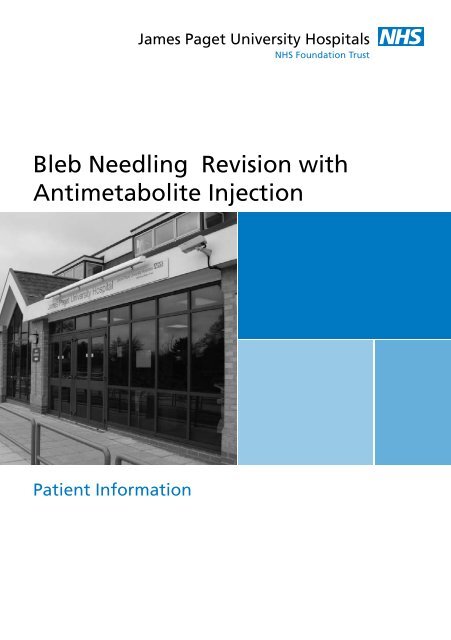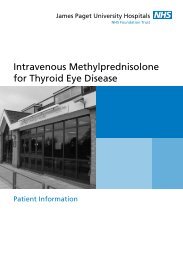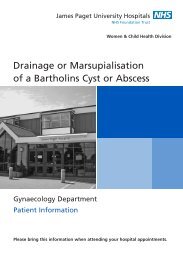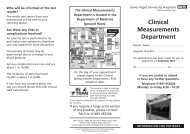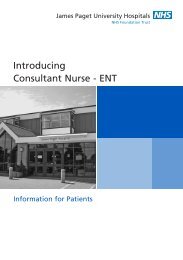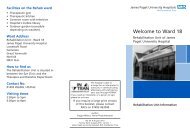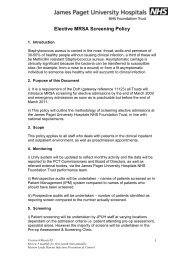Bleb Needling Revision with Antimetabolite Injection - James Paget ...
Bleb Needling Revision with Antimetabolite Injection - James Paget ...
Bleb Needling Revision with Antimetabolite Injection - James Paget ...
You also want an ePaper? Increase the reach of your titles
YUMPU automatically turns print PDFs into web optimized ePapers that Google loves.
<strong>James</strong> <strong>Paget</strong> University Hospitals<br />
NHS Foundation Trust<br />
<strong>Bleb</strong> <strong>Needling</strong> <strong>Revision</strong> <strong>with</strong><br />
<strong>Antimetabolite</strong> <strong>Injection</strong><br />
Patient Information
What is bleb needling?<br />
During your glaucoma surgery (Trabeculectomy) a<br />
small opening is made under the upper eyelid, to let<br />
the fluid escape and lower the pressure. The fluid that<br />
flows out of your eye forms a small cyst, called a bleb,<br />
which is under the conjunctiva, the thin transparent<br />
layer that covers the white of your eye.<br />
Drainage surgery for glaucoma (Trabeculectomy) may<br />
fail to bring the pressure low enough or may scar<br />
and fail. This can occur shortly after the operation is<br />
performed or at any time. In some cases bleb needling<br />
may be the next step to restore drainage and achieve a<br />
lower eye pressure.<br />
What does the procedure involve?<br />
The needling is usually done in the operating theatre.<br />
You will be asked to attend the ward in advance of the<br />
treatment time. Further advice about this will be given<br />
in the letter discussing your admission details. The<br />
doctor will take your written (informed) consent and<br />
explain further if you have any questions.<br />
The procedure is usually done under local anaesthetic<br />
however some patients may require a general<br />
anaesthetic. This will be discussed <strong>with</strong> you prior to<br />
your admission.<br />
The local anaesthetic involves putting in drops that<br />
numb the front surface of your eye.<br />
The needling involves breaking down the wall of the<br />
scar tissue using a fine needle. This will help to improve<br />
the drainage of the watery fluid called aqueous
humour. A jelly like material and an anti-scarring<br />
drug is then injected to try to prevent further scar<br />
formation.<br />
At the end of the procedure, antibiotic and steroid is<br />
given to reduce the risk of infection and inflammation.<br />
Afterwards an eye pad or clear shield will be placed<br />
over your eye.<br />
Are there any risks or side effects of this<br />
treatment?<br />
• The most sight threatening problems that can occur<br />
are bleeding inside the eye, or a serious infection.<br />
Antibiotics at the surgery and then drops are given<br />
to help to prevent infection. These complications are<br />
rare and occur in less than 1 in 1000 operations.<br />
• The pressure in the eye may rarely go too low after<br />
the operation and require further intervention.<br />
• The anti-scarring agent may cause the wound to leak<br />
or may change the surface of the cornea (the clear<br />
window at the front of your eye). This recovers in<br />
almost all cases.<br />
After the needling you may experience some slight<br />
discomfort. You may wish to take a mild painkiller, for<br />
example Paracetamol, to relieve this discomfort. If you<br />
are already taking painkillers for a different condition<br />
continue <strong>with</strong> these, but do not take both.<br />
These are the same risks that are present when<br />
undergoing the glaucoma drainage operation<br />
(Trabeculectomy).
What is the success of bleb needling?<br />
The procedure works in more than half the eyes<br />
operated on to restore and improve drainage. It is<br />
most successful if the trabeculectomy operation has<br />
been performed recently.<br />
The information here is intended as a guide only,<br />
as each patient’s experience will be different. If you<br />
require any further information or are concerned<br />
about your eye following this procedure, please<br />
contact your consultant’s secretary.<br />
The hospital is able to arrange for an<br />
interpreter to assist you in communicating<br />
effectively <strong>with</strong> staff during your stay<br />
through INTRAN.<br />
If you need an interpreter or a person to sign,<br />
please let us know.<br />
If you require a large print version of this<br />
booklet, please contact PALS on<br />
01493 453240<br />
Author:<br />
Subhanjan Mukherji,<br />
Consultant Ophthalmologist<br />
© August 2012<br />
<strong>James</strong> <strong>Paget</strong> University Hospitals NHS<br />
Foundation Trust<br />
Review Date: August 2015<br />
OP 48 version 1


